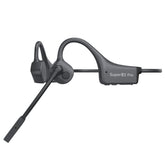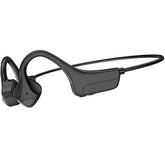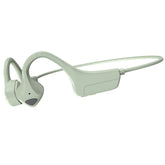WHAT IS BONE CONDUCTION?
WHAT IS BONE CONDUCTION?
Bone conduction is the transmission of sound vibrations to the inner ear (cochlea) bones of the skull, which allows you to perceive sound without blocking the ear canal. Even more simply put: it’s sound that is delivered directly to the inner ear without needing to pass through the eardrum. Think of bone conduction as a shortcut to hearing sound.
Have you ever plugged your ears and sang a song, but wondered how you can still hear the tune? Or heard the sounds generated from brushing your teeth or eating potato chips? That’s bone conduction at its finest, and, along with more commonly used air conduction, your ears have been transmitting sound that way all along!
Unlike traditional in-ear or on-ear headphones that utilize air conduction, Bone conduction headphone has mastered the natural phenomenon of bone conduction by adapting it to consumer electronics, and it’s now the secret behind the success of our open-ear product line. Here’s how we’ve harnessed bone conduction technology to work for our products:
1. Audio Enters The Transducer
Every Samvek audio device features two transducers on either side. These transducers, positioned near the cheekbone, work to convert audio signals into mechanical energy (vibrations) which is then sent to your cheekbones.

The Difference Between Bone Conduction Open-Ear Headphones and Air Conduction Open-Ear Headphones:
Bone Conduction Open-Ear
The popularity of open-ear headphones has proved the importance of environmental awareness for consumers, and Samvek bone conduction headphones allow for the most natural open-ear listening experience with minimal sound leakage, don’t fatigue the outer or middle ear, and stay put through any activity. By nature, it’s hard for bone conduction to outperform air conduction in terms of bass, but Samvek have been praised by experts worldwide for their overall audio quality, featuring 8th generation bone conduction technology for a deeper bass, crystal-clear midrange and crisp highfrequency performance, while also being ultra-lightweight and ergonomically designed for a comfortable, snug fit.
Air Conduction Open-Ear
Open-ear headphones powered by air conduction work a little differently. With this design, two holes are added on the earbud; one hole, located close to the ear, transmits sound through the air to the ear. The other hole, located on the opposite side of the earbud, reduces sound leakage using anti-phase sound. While this open-ear design delivers some situational awareness, it requires a louder volume to ensure sound clarity (therefore drowning out ambient noise) and a larger battery capacity, which causes an increase in the weight of the earbuds or headphones. This combined with their loose fit could cause the earbuds to move and shift during high-impact activities.








